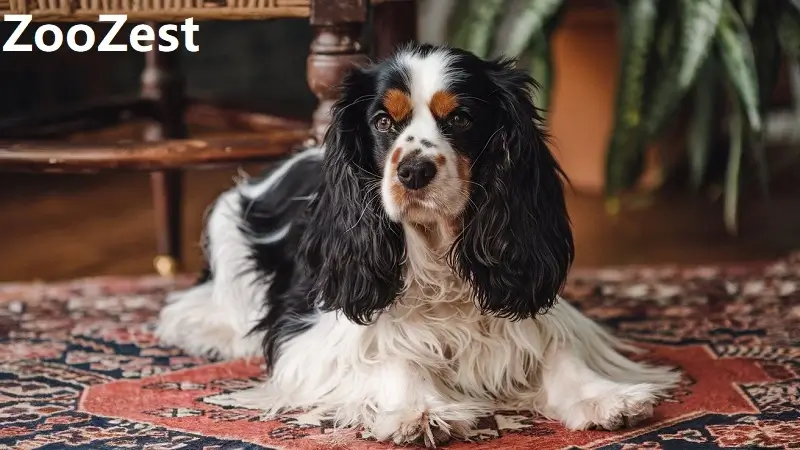- What is a King Charles Spaniel?
- History of the King Charles Spaniel
- King Charles Spaniel vs. Cavalier King Charles Spaniel
- Appearance of the King Charles Spaniel
- Personality and Temperament of the King Charles Spaniel
- Health Concerns of King Charles Spaniels
- Grooming and Care for King Charles Spaniels
- Training King Charles Spaniels
- Are King Charles Spaniels the Right Dog for You?
- Key Takeaways
- Conclusion
- FAQs:-
- Also Read:-
King Charles Spaniel can be the right fit if you are searching for an affectionate, small-sized, charming, and faithful companion with a royal bloodline. Their amorous nature and their coats of lavish beauty make these little dogs generally cherished for all that is good. In this article, we throw light on everything about King Charles Spaniels-from history and appearance to care needs and personality.
What is a King Charles Spaniel?
This sometimes has been confused with the Cavalier Royal Charles Spaniel.
However, this one of the toys that have been bred by the British royalties. They are very small, elegant dogs having a sweet face and dark eyes and have silky, feathered coat. Friendly and Affectionate, king Charles Spaniels make excellent companion animals, really flourishing in family situations or with individuals who can provide them with regular companionship.
History of the King Charles Spaniel
The Dog has a storied and ancient line that traces itself back to the Renaissance, where they had apparently been a favorite of the English nobility. They are most famously known as the favorite breed of King Charles II, who would not want to be separated from his Spaniels, even to the point of allowing the Spaniels into court and Parliament sessions. Over time, breeders bred these dogs with shorter muzzles and larger eyes, which makes up the unique look of the King Dog of today.
King Charles Spaniel vs. Cavalier King Charles Spaniel
Where the King Charles Spaniel and the Cavalier King Charles Spaniel are different animals-even though they share the same ancestors-is that this breed is often referred to as an English Toy Spaniel in America and tends to be a bit smaller and have a more rounded head with a relatively shorter muzzle than the Cavalier, which has a slightly longer face and a more defined stop. But notwithstanding this, both breeds are very affectionate and have a naturally gentle nature.
Appearance of the King Charles Spaniel
The King Charles Spaniels have an exclusive appearance that makes them separate from any other toy breeds. They possess a hard body, round head, and big dark eyes. In addition to that, they have a short-upturned nose. They have a soft, long, and their coat requires grooming to be done very often if it is going to be pretty and healthy. They come in several colors of coats: Best Dog Companion
- Blenheim: Chestnut markings on a white background, often with a unique “thumbprint” on the head.
- Prince Charles (Tri-color): Black, white, and dark markings.
- Ruby: A rich, solid chestnut color.
- King Charles (Black and Tan): Dark marked with tan markings on face, chest, and legs.
Personality and Temperament of the King Charles Spaniel
The King Charles Spaniels are warm-hearted and loving. They love being around family members, and they are very loyal. They are rather loving breeds and are hence called “lap dogs.” They tend to get along pretty well with the children and other pets, thus making them a wonderful choice for a family. Though they do require constant interaction and can turn fretful if left alone for many hours.

Health Concerns of King Charles Spaniels
They are usually in good health; however, King Charles Spaniels tend to be prone to specific health problems. This would be important to know and make the right choices to keep your dog healthy.
- Mitral Valve Disease (MVD): A common heart condition in small dog breeds that requires monitoring.
- Syringomyelia: A neurological condition affecting the spine, often more common in breeds with short muzzles.
- Eye Problems: Issues like cataracts and dry eye are common due to their prominent eyes.
- Ear Infections: Their long, drooping ears can trap moisture, leading to infections if not cleaned regularly.
Grooming and Care for King Charles Spaniels
roper grooming is, therefore, a prime requirement to keep a King Charles Spaniel not only looking but also feeling best. Their coat must be brushed several times a week to avoid entanglements and knots, and regular baths, nail trims, and ear cleaning are essential in avoiding hygiene-related health issues.
These small-sized dogs are to be exercised at moderate levels. Provided with some playtimes and a daily walk, they would be satisfied when given ample mental and physical stimulation.
Training King Charles Spaniels
King Charles Spaniels are cute smart, trainable, and very ready to please. They respond very well to positive reinforcement methods and like learning new tricks and commands. These dogs bloom with confidence in time and respond to new environments and people around them.
Are King Charles Spaniels the Right Dog for You?
King Charles Spaniels may knock directly into your life in case you seek a companion that is affectionate, loyal, and thrives with an environment that is family-oriented. This breed thrives best under the hands of people who can offer it the attention and love that it demands. However, their health tendency to suffer from separation anxiety may not suit people who often happen to be away from home. Mystery illness
Key Takeaways
- Origin: England, with a strong royal association.
- Size: Small, typically 8-14 pounds.
- Coat: Long, silky, requires regular grooming.
- Temperament: Affectionate, gentle, and loyal.
- Lifespan: 10-14 years on average.
- Common Health Concerns: Mitral Valve Disease, syringomyelia, eye and ear problems.
Conclusion
The King Charles Spaniel is a really noble and charming breed, friendly and gentle of temperament, with striking looks. For whether your apartment or house, these are very adapting dogs, as long as they have the proper socialization. By being cognizant of their care requirements, any health conditions to which they may be predisposed, and their temperament, you can establish a happy, loving environment for your devoted little friend.
As you opt for a King Charles Spaniel as your family pet, you are not just bringing a pet into the home; you are inviting a piece of history to be part of your life: a legacy of loyalty, love, and regal charm that’s sure to bring wonderful richness into it.
FAQs:-
What are the negatives of the cavalier king charles spaniel?
Cavalier King Charles Spaniels could be prone to several health problems, amongst which are heart conditions (Mitral Valve Disease), ear infections, and conditions like syringomyelia, a neurological disorder. They do require regular grooming and could develop separation anxiety because these dogs have such a great need for people interaction.
What’s the difference between a cavalier king charles and a king charles?
The most major size and visual differences: The Cavalier King Charles Spaniels are slightly bigger with longer, more defined muzzles. The King Charles Spaniels are smaller, flatter-faced with a more domed skull. Both are affectionate, but the Cavalier is more energetic, whereas the King Charles is more laid-back.
Are King Charles Spaniels good family dogs?
Yes, King Charles Spaniels are family dogs; they are loving, gentle, great with children, and other pets, so they are ideal for families that want a loyal and friendly companion.
Do Cavaliers bark a lot?
Cavalier King Charles Spaniels barely bark. They make noise and get excited when there is a presence of a stranger, but they are relatively quiet compared to other breeds.
Can Cavaliers be aggressive?
Cavalier King Charles Spaniels are known to be really friendly and gentle but show aggression rarely in this breed. Any dog may possess a variety of behavioral disorders if it fails to get socialized properly or is handled poorly.

